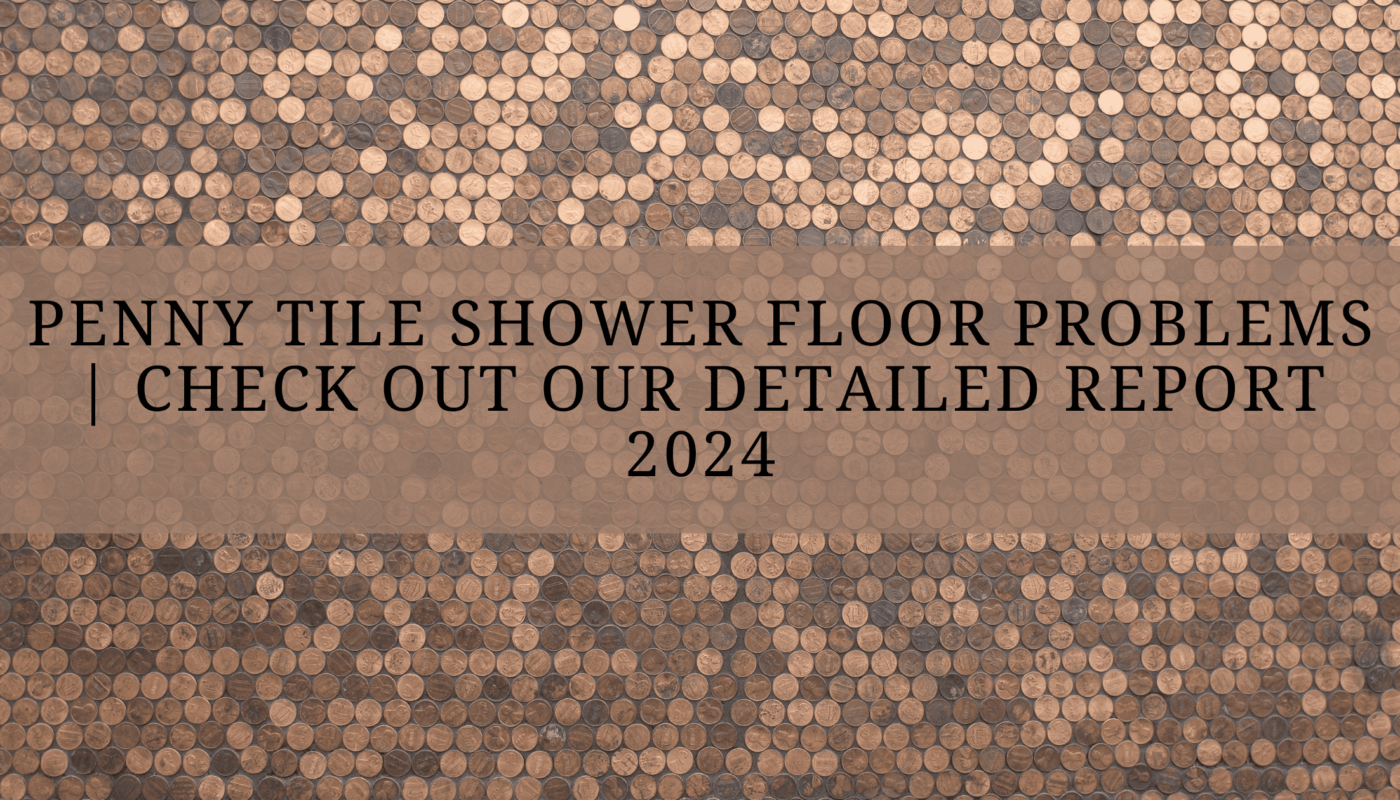Table of Contents
Introduction
Penny tile shower floors have gained popularity for their unique and eye-catching designs,(Penny Tile Shower Floor Problems) but like any other flooring option, they come with their share of challenges. Addressing these issues promptly is crucial to maintaining a functional and aesthetically pleasing bathroom space.
Grout Issues:
Grout Staining
Explanation: Penny tiles, being smaller in size, result in more grout lines per square foot compared to larger tiles. Grout is a porous material, and when there are numerous grout lines, there is an increased likelihood of it absorbing liquids, such as water, soap, or mineral deposits. Over time, these substances can lead to staining and discoloration of the grout. Staining may also occur if the grout wasn’t adequately sealed during installation.
Difficult to Clean
Explanation: Cleaning the grout lines between penny tiles can be challenging due to their small size and the intricacy of the patterns. The spaces between the tiles are narrow, making it harder to reach and clean effectively. Regular cleaning is essential to prevent the accumulation of soap scum, mold, or mildew in the grout lines. The labor-intensive nature of cleaning small grout lines can be time-consuming and may require more effort compared to larger tiles with wider spacing.
Slippery Surface:
Uneven Grout Lines
Explanation: The grout lines between penny tiles can sometimes be uneven due to variations in the installation process. If the grout lines are not level with the surface of the tiles, they can create slight depressions or raised areas. When the shower floor is wet, water can collect in these uneven areas, creating a surface that is potentially slippery. The uneven grout lines can be especially problematic if the water is not able to drain properly, leading to an increased risk of slipping.
Reduced Traction
Explanation: Smaller tiles, such as penny tiles, inherently have more grout lines per square foot compared to larger tiles with wider spacing. The increased number of grout lines means there is less surface area of the actual tile to provide traction. In a wet environment like a shower, where water and soap are present, the reduced tile surface and the abundance of grout lines contribute to a floor with less overall traction. This can make the floor more slippery, especially when compared to larger tiles where the tile surface itself provides more grip.
Installation Challenges:
Labor-Intensive
Explanation: Installing penny tiles is labor-intensive due to their small size and the intricate patterns often created with these tiles. The small size of each individual tile means that more tiles need to be laid per square foot compared to larger tiles. This requires careful placement and adjustment of each tile to achieve the desired pattern, which can be time-consuming. Additionally, the installation process involves working with numerous small pieces, necessitating a higher level of precision and attention to detail.
Requires Skilled Labor
Explanation: Achieving a smooth, level surface with penny tiles requires a skilled installer with experience in working with smaller tiles. The installer must ensure that each tile is set evenly and that the grout lines are consistent throughout the installation. The intricate patterns common with penny tiles demand a high level of craftsmanship to maintain a visually appealing and cohesive design. Skilled labor is essential to prevent issues such as uneven surfaces, misaligned patterns, or difficulties in cleaning and maintaining the grout lines.
Mold and Mildew:
Moisture Retention
Explanation: Penny tile shower floors have more grout lines due to the smaller size of the tiles. Grout is a porous material, and the increased number of grout lines means there are more areas for water to be absorbed. If the moisture is not properly managed or if the grout was not sealed adequately during installation, it can become trapped in the grout lines. This trapped moisture creates an environment conducive to the growth of mold and mildew, as these microorganisms thrive in damp conditions. The combination of small tiles and numerous grout lines can make it challenging for the shower floor to dry thoroughly between uses, exacerbating the risk of mold and mildew development.
Regular Maintenance
Explanation: To prevent the growth of mold and mildew in penny tile shower floors, regular maintenance is crucial. Cleaning the grout lines and tiles on a consistent basis helps remove any accumulated soap scum, mineral deposits, or other substances that can foster mold and mildew growth. Additionally, sealing the grout periodically is important to create a protective barrier that minimizes water absorption and enhances the resistance to mold and mildew. Regular maintenance not only preserves the cleanliness and appearance of the shower floor but also helps in preventing potential health hazards associated with mold and mildew.
Uneven Surface:
Subfloor Preparation
Explanation: Penny tiles, being smaller in size, are more sensitive to imperfections in the subfloor beneath them. If the subfloor is not adequately prepared before installation, irregularities such as bumps, dips, or unevenness may become more apparent when the smaller tiles are laid. These imperfections can affect the levelness and stability of the penny tiles. Thorough subfloor preparation involves ensuring that the surface is smooth, level, and free from any structural issues. In cases where the subfloor is not properly prepared, it can lead to an uneven installation, potentially causing tiles to be unevenly set or creating an irregular appearance.
Surface Irregularities
Explanation: Smaller tiles, like penny tiles, can magnify any irregularities in the installation surface. Uneven surfaces can cause variations in the height of the tiles, resulting in a floor that is not level. Since penny tiles are typically set close together with minimal grout lines, even slight variations in the surface can become more noticeable. These surface irregularities not only affect the aesthetics of the floor but can also create challenges in terms of maintenance and cleaning. Additionally, an uneven surface may impact the overall stability and durability of the installation.
Durability Concerns:
Chipping
Explanation: Smaller tiles, such as penny tiles, have more exposed edges compared to larger tiles. This increased number of edges makes them more susceptible to chipping, especially in high-traffic areas where the tiles may be subjected to impacts from foot traffic, dropped items, or other stressors. The smaller size of each individual tile means that each one is more vulnerable to damage, and chipping can affect the overall appearance and integrity of the floor. Additionally, chipped edges can create sharp points that may pose safety concerns.
Wear and Tear
Explanation: Over time, both grout and tiles in a shower floor may experience wear and tear due to the constant exposure to water, cleaning agents, and foot traffic. The grout lines between penny tiles can be particularly susceptible to wear, as the porous nature of grout makes it more prone to erosion and discoloration. Additionally, the smaller size of penny tiles means there are more grout lines, which may require more frequent maintenance to address issues like staining and deterioration. In some cases, the tiles themselves may also show signs of wear, particularly in high-traffic areas, necessitating maintenance or, in severe cases, replacement.
Aesthetic Challenges:
Scale and Proportion
Explanation: The small size of penny tiles may not always be suitable for the overall design or size of a shower space. In some cases, using small tiles in a larger area can make the space appear busy or visually overwhelming. Conversely, in a smaller shower, the intricate patterns created by numerous small tiles might not be as noticeable or appreciated. Achieving a balanced and aesthetically pleasing design with penny tiles requires careful consideration of the scale and proportion of the tiles in relation to the size and style of the shower space.
Grout Color Variations
Explanation: The grout used with penny tiles plays a significant role in the overall appearance of the floor. Variations in grout color can impact the visual cohesion of the floor. Uneven grout color or inconsistent application can create a distracting or disjointed look. Additionally, over time, grout may discolor due to factors such as staining, wear, or aging, further affecting the overall aesthetic. Careful selection of grout color and attention to the grouting process are essential to achieving a harmonious and visually pleasing result.
Cost Considerations:
Higher Cost
Explanation: Penny tiles, especially those made of natural materials or featuring intricate designs, tend to be smaller in size and more labor-intensive to produce. The smaller size of each tile requires more material and precision during the manufacturing process, which can contribute to a higher cost per square foot compared to larger tiles. Additionally, the use of premium or natural materials in penny tiles can further elevate the overall cost. As a result, when choosing penny tiles for a shower floor, homeowners may encounter a higher upfront cost compared to selecting larger, more conventional tiles.
Increased Installation Costs
Explanation: The installation of penny tiles can be more complex and labor-intensive compared to larger tiles. The small size of penny tiles requires meticulous placement to achieve the desired patterns, and the installation process involves handling a greater number of individual tiles per square foot. This complexity in installation can result in higher labor costs, as skilled labor is needed to ensure a precise and visually appealing outcome. The intricate patterns may also require more time and effort to lay out and set, contributing to increased installation costs. Homeowners should be aware that the intricacy of penny tile installations may necessitate the hiring of experienced professionals, further impacting the overall cost of the project.
Limited Design Options:
Pattern Limitations
Explanation: The small size of penny tiles imposes certain limitations on the range of patterns that can be achieved compared to larger tiles. While penny tiles are versatile and can be arranged in various layouts, the intricate patterns or complex designs may be challenging to achieve due to the size constraints. Elaborate patterns that require larger tile surfaces may not be as feasible with penny tiles. This limitation can influence the overall design possibilities for the shower floor, and homeowners may find that their choices are somewhat constrained compared to using larger tiles that offer more flexibility in pattern design.
Modern vs. Traditional
Explanation: Penny tiles are often associated with more traditional or vintage styles, as they have been used in classic designs for many years. This association can limit the design choices for homeowners seeking a more modern or contemporary aesthetic. While penny tiles can certainly be incorporated into modern designs, the challenge lies in overcoming the traditional connotations that may be associated with these smaller, classic tiles. Homeowners looking for sleek, minimalist, or cutting-edge designs may find that the perceived traditional nature of penny tiles limits their options in achieving a thoroughly modern look in the shower area.
Maintenance and Repairs:
Individual Tile Replacement
Explanation: Repairing or replacing individual penny tiles can be a complex and intricate process. The small size of penny tiles means that each tile is a critical part of the overall pattern and design. When a single tile is damaged or needs replacement, it requires careful removal without disturbing the surrounding tiles or the grout lines. Matching the replacement tile to the existing tiles in terms of color, size, and pattern is crucial for maintaining a cohesive appearance. The intricate nature of penny tile installations may make the process more labor-intensive and challenging compared to larger tiles, where individual tile replacement is often more straightforward.
Sealing Requirements
Explanation: Regular sealing of both the tiles and grout is essential for maintaining the integrity and longevity of a penny tile shower floor. Penny tiles often have more grout lines due to their small size, making the grout more susceptible to moisture penetration, staining, and deterioration. Sealing the grout helps create a protective barrier, reducing water absorption and minimizing the risk of mold and mildew growth. Additionally, sealing the tiles themselves, especially if they are made of natural materials, provides an extra layer of protection against water damage and staining. Regular maintenance of the sealant is necessary to ensure continued effectiveness over time.
Conclusion:
In conclusion, while penny tile shower floors offer a stylish choice for bathrooms, being aware of potential problems and addressing them proactively is key to a successful installation. By following professional advice and investing in quality materials, homeowners can enjoy the beauty of penny tiles without compromising on functionality.




